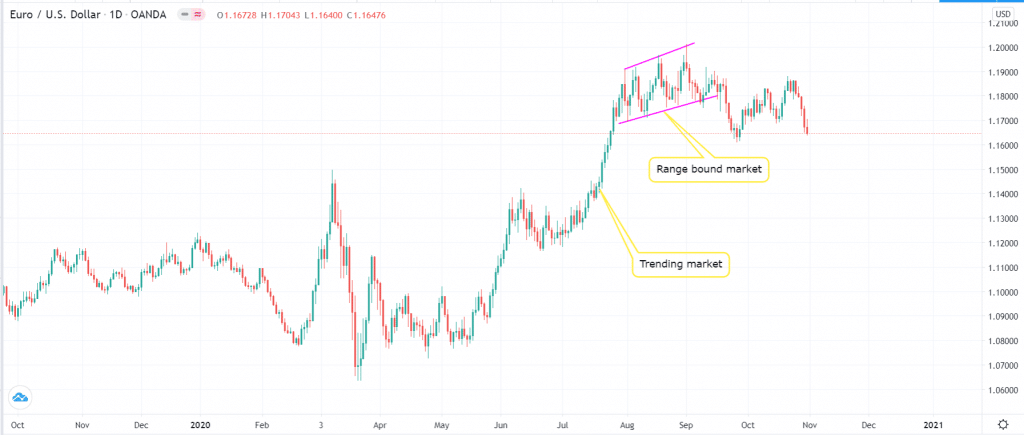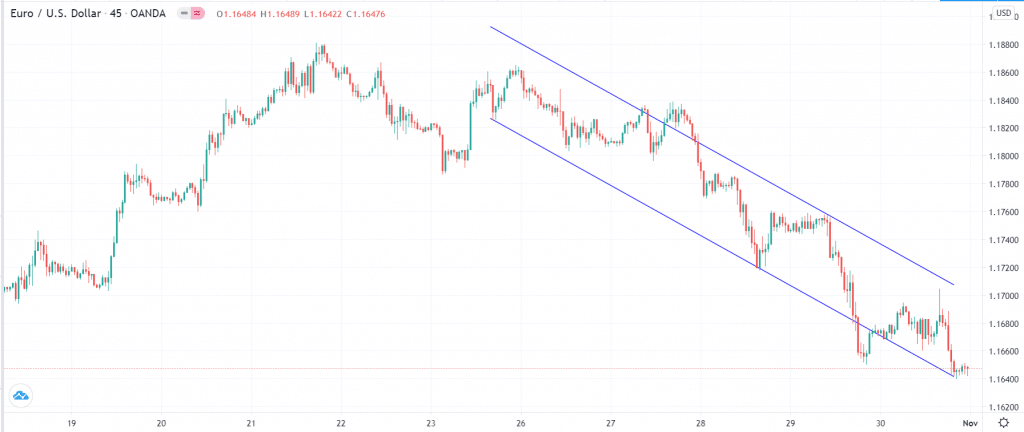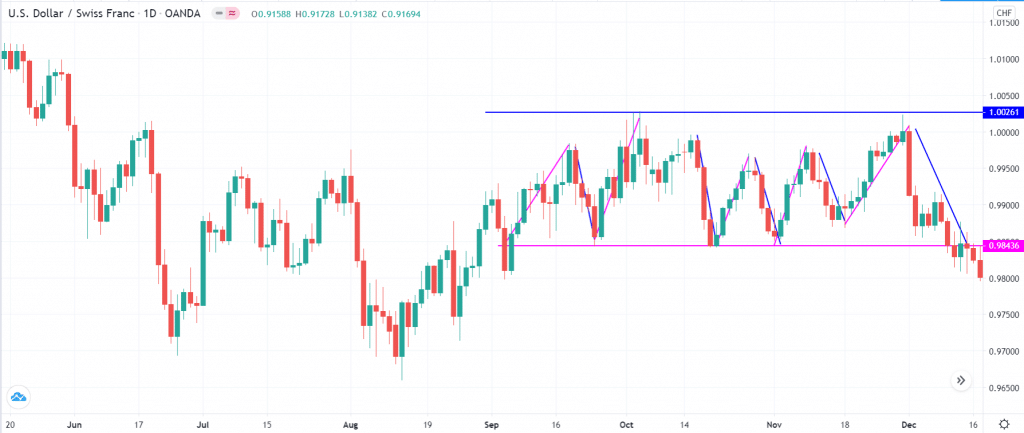A range-bound market is a market that is going nowhere. It happens when the price of a currency pair, stock, commodity, or exchange-traded fund bounce between two levels, often in a horizontal direction. The opposite of such a market is a trending market, where the price of an asset is rising or falling. It is also unlike a volatile market, where an asset cost has no defined direction. Below, we will look at the best approach to trade a range-bound market.
Range bound market vs. a trending market

Checking multiple timeframes
The first thing we recommend whenever you spot an asset trading in a range is to look at other timeframes. That is because an asset would seem to be in a tight range on a daily or weekly chart but have a different trend on a smaller timeframe chart. This divergence happens because of the way candlesticks are created. For example, in a weekly chart, each candle represents a week, while in a four-hour chart, each candle represents four hours.
A good example of this is using the daily chart shown above. As you can see, the chart is generally in a tight range in this chart. However, when you shift to a 45-minute chart, you realize that the chart is actually trending lower, as shown below. Therefore, checking out multiple timeframes can give you a different angle of the market.
45-minute EUR/USD chart

Drawing support and resistance
Another important strategy when trading range-bound markets is to have knowledge about support and resistance. These are mandatory skills if you want to trade these markets successfully. Ideally, support is a floor where the price of an asset struggles to move below. It is usually formed when short sellers start losing confidence in their bearish thesis.
On the other hand, resistance is a ceiling, where the price struggles to move above. It usually forms when buyers start losing confidence that the price will continue rallying.
In most cases, the basic approach is to buy when the asset price moves to the support and then short it when it moves to the resistance. Depending on the size of the range, opening such trades can make you a substantial amount of money.
A good example of this is on the USD/CHF pair shown below. As you can see, the price was struggling to move below the 0.9843 support level that is shown in pink. This was the support of this range. At the same time, the price was struggling to move above 1.000, which is the resistance.
Therefore, an ideal range-bound trading strategy is to buy when the price hits a support level and then put a stop loss when it hits the resistance level. In this case, you will make money when the price is rising and also when it moves below the resistance. However, as shown above, it is always important to have your trades slightly above the support and below the resistance.
Example of using support and resistance in range-bound markets

Be careful of breakouts
A common fact about range-bound markets is that they don’t last forever. Indeed, the eventual outcome of ranges is that they break out. Therefore, the main risk of using the support and resistance levels when trading market ranges is that the price could break out. Fortunately, there are strategies for playing these breakouts well.
First, whenever you buy at the support, you need to have a stop loss a few pips below this level. This stop loss will stop your trade immediately when the price moves significantly below the support. Similarly, you should have a stop loss above the resistance to protect yourself from these breakouts.
Second, unlike the popular opinion, it is not always advisable to short after a bearish breakout or buy immediately after a bullish breakout. That is because, in most cases, these are usually false breakouts. In most cases, the right strategy is to wait for the price to retest the support or resistance and then trade in the breakout direction.
In the example above, we see that the USD/CHF pair moved below the support at 0.9843 and then found another support at 0.9613. It then rose, tested the former support – and now resistance – and then continued with the downward trend. This is shown in the chart below.
Avoiding false breakouts

Using technical indicators in range markets
To be fair, I don’t believe that technical indicators are the best strategies to use when trading in ranging markets. Instead, you should mostly focus on price action and candlestick analysis. However, there are some indicators that work well during these markets. For example, you can use the Bollinger band to identify key levels.
Ideally, in this, you should pay close attention to the middle line. If you buy at the support and then the price manages to move above the middle line of the Bollinger Band, it is a sign that bulls are in control and that the price will have better chances to test the upper side of the band. Similarly, if you short at the resistance level and the price manages to move below the Bollinger band middle line, it is a sign that the price will likely reach the support level. An example of this is shown in the EUR/USD chart below.
EUR/USD using Bollinger bands

Final thoughts
Range markets happen all the time in the Forex market. They tend to happen when there is no major news event happening. Also, they happen when there is significant news from both countries of the currencies. For example, in a EUR/GBP pair, a range market can happen when both the European Central Bank (ECB) and the Bank of England (BOE) are all dovish. In such a situation, traders are usually uncertain about where the pair will go next.
Fortunately, as shown above, there are various trading strategies both during the ranging market and during the breakouts.




